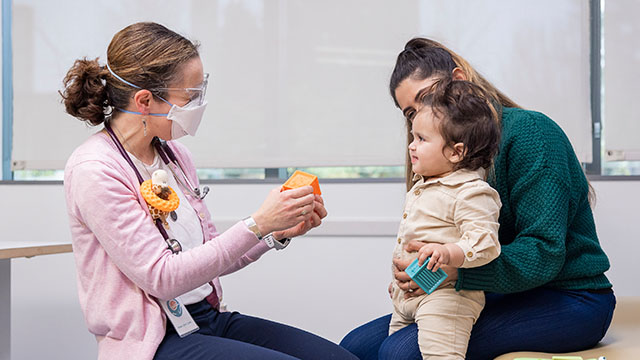Lipomyelomeningocele
Contact the Neurosciences Center
What is a lipomyelomeningocele?
A lipomyelomeningocele (li-PO-my-uh-lo-meh-NIN-guh-seal) is a fatty mass that affects a child’s backbone (spine). It looks like a large lump under the skin. The mass attaches to the and may slowly pull on it. The spinal cord can become stuck (tethered), instead of floating freely in the . As your child grows, a tethered spinal cord will stretch like a rubber band. If the problem is not treated, it can lead to nerve damage and loss of function, like the ability to walk or control their bladder.
A lipomyelomeningocele may form as the developing baby () grows early in pregnancy. It is present when a baby is born (congenital). Doctors do not know why this happens.
Neurosciences Care at Seattle Children's
What are the symptoms of a lipomyelomeningocele?
In most babies, a lipomyelomeningocele looks like a large lump under the skin, usually in the middle of the back. But sometimes, there is no lump or other mark on a baby’s back.
All babies with a lipomyelomeningocele have a spinal cord that is stuck (tethered) into the fatty mass on their back. This may pull the spinal cord down. Tethered spinal cord can cause symptoms, such as:
- Back and leg pain
- Weak and numb legs
- Changes in bladder and bowel control
- Frequent falls
- In-turning of the feet or orthopedic deformities
How is a lipomyelomeningocele diagnosed?
Sometimes doctors detect the condition before birth during routine pregnancy tests. If so, specialists at our Fetal Center will assess your baby’s health to prepare for their birth and care.
Usually, doctors can see a lipomyelomeningocele when a baby is born. They may see a lump or some other type of mark on your baby’s back, such as a fat pad, birthmark, dimple or tuft of hair.
We will use MRI (magnetic resonance imaging) to get a better view of your baby’s spinal cord and any problems.
Sometimes, there is no outward sign of a lipomyelomeningocele, and it causes no symptoms. These children may be diagnosed later in life if symptoms start or if an MRI scan done for some other reason shows the lipomyelomeningocele.
How is a lipomyelomeningocele treated?
Most babies with a lipomyelomeningocele have surgery before age 1.
During surgery:
- First, your child’s removes parts of some bones (vertebrae) in your child’s spine. This procedure (called laminectomy) provides access to the spinal cord or spinal nerve roots that need repair.
- We use advanced to make your child’s surgery as safe as possible.
- Next, the neurosurgeon removes some of the fatty mass to free the spinal cord. The surgeon uses a laser for increased precision and to reduce bleeding and scarring.
- Then the neurosurgeon and a plastic surgeon close the hole where the fatty mass enters the spinal canal. They use the coverings of the spinal cord (dura) to close the defect.
Read about Laminectomy: Care after Surgery (PDF) (Spanish) (Russian) (Vietnamese).
Even after surgery to repair a lipomyelomeningocele, there is a chance the cord will attach again as your child grows. Some children need more surgeries.
Why choose Seattle Children's for lipomyelomeningocele care?
Your child will be in the hands of experts. We have a lot of experience treating babies and children with lipomyelomeningoceles and tethered spinal cords. Seattle Children's Spina Bifida Program has been named a Clinic Care Partner by the Spina Bifida Association (SBA), the national leader in providing research, education, support, clinical care and advocacy to people affected by SB. Seattle Children’s neurosurgery team is among the most experienced in the nation and the most experienced by far in the Pacific Northwest.
We use advanced and special lasers to make your child’s surgery as safe as possible.
Children with this condition often have complex problems that need special care. At Seattle Children’s, we bring many experts together in 1 clinic to treat your child. Based on your child’s needs, the team may also include experts from Urology, Neurodevelopmental, Orthopedics and Rehabilitation.
Contact Us
If you would like an appointment, ask your child’s primary care provider for a referral. If you have a referral, call 206-987-2016 to make an appointment.
Providers, see how to refer a patient.
If you have questions, contact us at 206-987-2016 or 844-935-3467 (toll free).
Paying for Care
Learn about paying for care at Seattle Children’s, including insurance coverage, billing and financial assistance.


